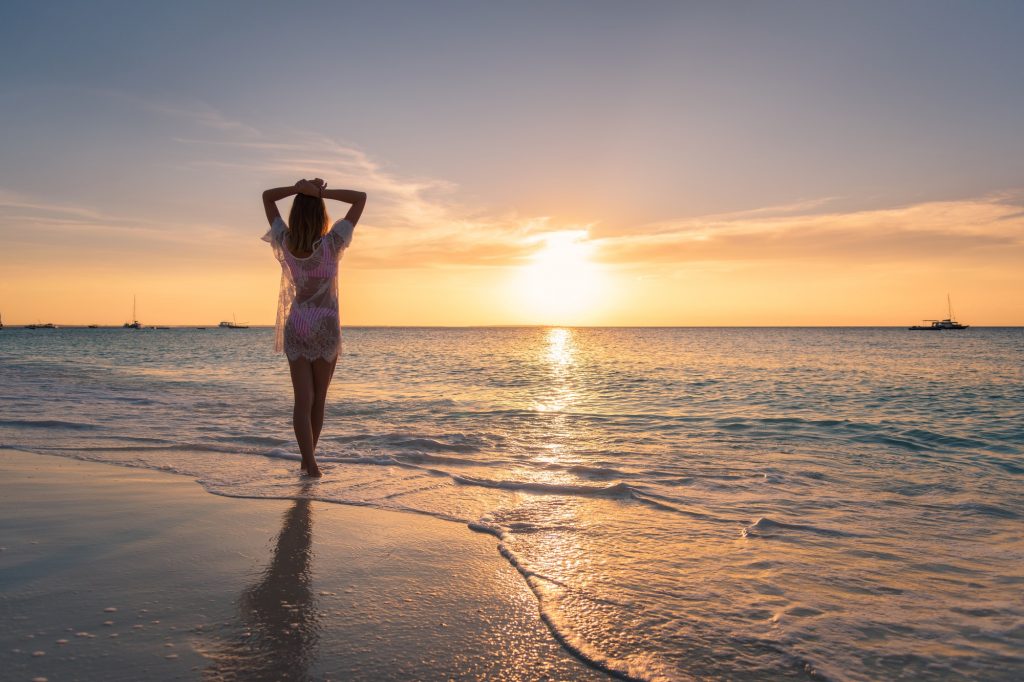Is Zanzibar an Island?
The Zanzibar archipelago consists of about 50 islands, starting from tiny outcrops to the larger, more populated islands of Zanzibar, more properly called Unguja and Pemba. The beaches are always stunning, with powdery white sand, shaded by palm trees.
The ocean is shallow, but venture further out into the sparkling, turquoise water and you will find coral reefs for nice snorkelling and diving. The larger islands are lush and highly fertile, all year round the air is suffused with the aroma of fruit and spices: it’s an intoxicating, exotic atmosphere.
Popular as a post-safari choice, a Zanzibar holiday also can be an excellent stand-alone escape. The most island offers an exceptional diversity of accommodation, from simple beach lodges and little boutique hotels to all-inclusive beach resorts and luxury hotels.
If you’re in search of a foreign island getaway, Tanzania’s Indian Ocean coastl has two other gems: Mafia Island, a long-time favourite of diving aficionados, and therefore the newly accessible hideaway of Fanjove.
For a quick summary of Zanzibar’s regions and therefore the differences between them, Although Zanzibar receives holiday visitors all year round, most of the people come outside of the most season , when Zanzibar’s weather is at its best, between June and February. This will link in perfectly with a safari in Tanzania, which very broadly shares an equivalent weather pattern.
Options for a Zanzibar beach holiday are too many, but broadly, the island are often divided into five areas: Nungwi within the north, the East Coast , the south-east, the West Coast , and a few offshore islands.
Two to three hours drive from Stone Town, the village of Nungwi marks the northern most tip of Zanzibar. Surrounded on three sides by turquoise-blue ocean, Nungwi has long been a magnet for visitors looking for paradise. Come for a few good diving and beaches, and proximity to an active village where there’s always tons happening.
Zanzibar’s East Coast is lined with long, powder-white beaches. To the north, numerous small resorts boast similar beaches, yet all are quite different. Offshore you’re find the magical Mnemba Island – the last word island lodge for those that can afford it.
Continuing along Zanzibar’s south-east coast, the beaches remain stunning: powder-white sand with a coral reef , many palm trees and a good lagoon between the beach and therefore the reef. The villages become a touch sleepier and more relaxed as you head south, and Jambiani, especially , is extremely relaxed indeed: for an authentic visit to a friendly village, you can’t beat it.
In south-west Zanzibar, the Fumba Peninsula may be a very laid-back and friendly corner of the island, with two good lodges, while offshore is that the award-winning eco-resort on Chumbe Island.
A 30-minute flight north-east of Zanzibar Island, Pemba Island is comparable in size, but much more traditional in outlook, and visitor numbers here are tiny.
Apart from a couple of honeymooners, most come for the diving, which may be excellent – although it’s really best suited to advanced divers.
Equally magical, although not a part of the Zanzibar Archipelago, is that the Mafia Archipelago. More remote, and quieter, than many places on Zanzibar, Mafia Island offers some superb diving and snorkelling in its own marine park, served by just a couple of small lodges. And new on the Tanzania beach holiday scene is Fanjove Island, a perfect spot to wind down after a safari in southern Tanzania.
What to expect on a Zanzibar beach holiday?
Sun, sea and sand: a Zanzibar beach holiday offers all these in abundance. Zanzibar’s beaches differ, but most feature crystal-clear waters lapping at the sting of powdery-white sand that trickles through the toes. Be aware, though, that off many beaches, especially on the East Coast , low water can reduce the broad, shallow lagoon to a virtually empty puddle, and swimming is usually only possible when the tide is in.
It is always worth consulting online tide tables, because the daily range along the East African coast varies through monthly and typically ranges from around 1 metre to more than 3 metres.
Zanzibar offers some excellent snorkelling, and world-class diving – which is centred around Mnemba Atoll to the north-west, and therefore the Menai Bay Conservation Area, to the island’s south-west. But albeit you’re not a water enthusiast, the prospect to look at the coastline from a standard wooden dhow isn’t to be missed.
The team at Wild Excursions &Safaris has visited almost every one of the 250 or so places to stay or having fun in Zanzibar to bring you a selection of the best.
ZANZIBAR’S STONE TOWN
Stone Town is said to be the only functioning ancient town in East Africa. It was an ancient trading port of the sultans of Oman in the 19th century.
During your stay you can take a tour (self-guided or guided) of the historic sites such as the Arab Fort, the House of Wonders and the Palace Museum – all taking you back in time.
It is a place of winding alleys, bustling bazaars, mosques and grand Arab houses whose original owners vied with each other over the extravagance of their dwellings.
This neighbourly rivalry is particularly reflected in the brass-studded, carved, wooden doors – there are more than 500 different examples of this handiwork. Most people enjoy ‘getting lost’ in the maze of Stone town’s narrow, winding and criss-crossing streets.
Location: Off the coast of Tanzania, a 2 hour ferry ride from Dar es Salaam or fly in to Zanzibar via the Northern Parks, Arusha, Dar es Salaam or the Southern Parks
Things to do: Spice Tour, Museum Visits, Visit Jozani Forest, and Visit Changuu Island’s Giant Tortoises
Time to visit: Requires at least one day to see most of Stone Town.

